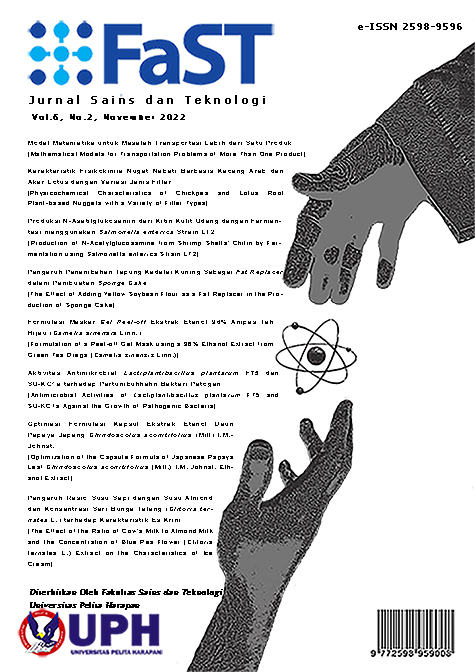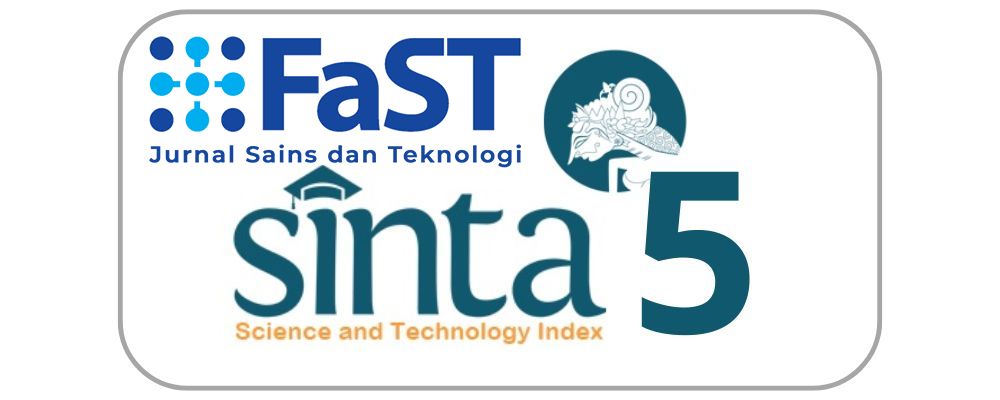PRODUKSI N-ASETILGLUKOSAMIN DARI KITIN KULIT UDANG DENGAN FERMENTASI MENGGUNAKAN Salmonella enterica STRAIN LT2 [PRODUCTION OF N-ACETYLGLUCOSAMINE FROM SHRIMP SHELLS’ CHITIN BY FERMENTATION USING Salmonella enterica STRAIN LT2]
DOI:
https://doi.org/10.19166/jstfast.v6i2.5920Keywords:
chitin, fermentation, microorganism, P. monodon, S. entericaAbstract
Chitin is found abundantly in shrimp shells and can be converted into N-acetylglucosamine, which has a wide range of uses in the biomedical and industrial fields. Chitin can be produced using chitinase produced by bacteria through the fermentation process. Salmonella enterica strain LT2 was one of the chitinolytic bacteria that was isolated from shrimp shells. This research aimed to determine the best pH (5, 6, 7, 8, and 9) and temperature (32oC, 37oC, and 42oC) of fermentation, as well as fermentation time (2, 3, 4, 5, and 6 days) for the production of N-acetylglucosamine using the S. enterica strain LT2. Results showed that the highest production of N-acetylglucosamine occurred at the temperature of 37oC, pH of 8, and 4 days of fermentation, which produced 69.62 ± 1.00 g/L of N-acetylglucosamine. Furthermore, the highest N-acetylglucosamine production for the fermentation time occurred on the third day which produced 73.19 ± 1.63 g/L of N-acetylglucosamine.
Bahasa Indonesia Abstract:
Kitin banyak ditemukan pada cangkang udang dan dapat dipecah menjadi N-asetilglukosamin, yang banyak digunakan dalam dunia biomedik maupun industri lainnya. Kitin dapat diproduksi menggunakan kitinase yang dihasilkan oleh bakteri melalui proses fermentasi. Salmonella enterica strain LT2 merupakan salah satu bakteri kitinolitik yang diisolasi dari cangkang udang. Penelitian ini bertujuan untuk menentukan pH (5, 6, 7, 8, dan 9) dan suhu fermentasi (32oC, 37oC, dan 42oC) terbaik, serta lama fermentasi terbaik (2, 3, 4, 5, dan 6 hari) untuk produksi N-asetilglukosamin menggunakan S. enterica LT12. Hasil penelitian menunjukkan bahwa produksi N-asetilglukosamin diperoleh pada suhu fermentasi 37oC, pH 8, dan waktu fermentasi 4 hari, yang menghasilkan N-asetilglukosamin sebesar 69,62 ± 1,00 g/L. Selain itu, produksi N-asetilglukosamin tertinggi terjadi setelah fermentasi pada hari ketiga, yaitu sebesar 73,19 ± 1,63 g/L.
References
Agrawal, T., & Kotasthane, A. S. (2012). Chitinolytic assay of indigenous Trichoderma isolates collected from different geographical locations of Chhattisgarh in Central India. Springerplus, 1(1), 65-73. https://doi.org/10.1186/2193-1801-1-73
Agustina, S., Swantara, I. M. D., & Suarta, I. N. (2015). Isolasi kitin, karakterisasi, dan sintesis kitosan dari kulit udang. Jurnal Kimia, 9 (2), 271-278.
Association of Official Analytical Chemistry (AOAC). (2005). Official methods of analysis of the association of official analytical chemistry. AOAC International.
Benhabiles, M. S., Salah, R., Lounici, H., Drouiche, N., Goosen, M. F. A., & Mameri, N. (2012). Antibacterial activity of chitin, chitosan and its oligomers prepared from shrimp shell waste. Food Hydrocolloids, 29(1), 48-56. https://doi.org/10.1016/j.foodhyd.2012.02.013
Chen, X., Liu, L., Li, J., Liu, J., Du, G., & Chen, J. (2012). Optimization of glucose feeding approaches for enhanced glucosamine and N-acetylglucosamine production by an engineered Escherichia coli. Journal of Industrial Microbiology and Biotechnology, 39(2), 359-365. https://doi.org/10.1007/s10295-011-1046-0
Cheng, H., & Yin, L. (2007). Medium effects on the increase of protease and cellulose activities of Bacillus subtilis BCRC14716. Journal of the Fisheries Society of Taiwan, 34 (3), 291-298. https://doi.org/10.29822/JFST.200709.0005
Chmielowski, R. A., Wu, H. S., & Wang, S. S. (2007). Scale-up of upstream and downstream operations for the production of glucosamine using microbial fermentation. Biotechnology, 2(8), 996-1006. https://doi.org/10.1002/biot.200600237
Deng, W., Liou, S. R., Plunkett III, G., Mayhew, G. F., Rose, D. J., Burland, V., Kodoyjanni, V., Schwartz, D. C., & Blattner, F. R. (2003). Comparative genomics of Salmonella enterica serovar Typhi strains Ty2 and CT18. Journal of Bacteriology, 185(7), 2330-2337. https://doi.org/10.1128/jb.185.7.2330-2337.2003
Dompeipen, E. J. (2017). Isolation and identification of chitin and chitosan from windu shrimp (Penaeus monodon) with infrared spectroscopy. Majalah Biam, 13(1), 31-41.
Dompeipen, E. J., Kaimudin, M., & Dewa, R. P. (2016). Isolasi kitin dan kitosan dari limbah kulit udang. Majalah Biam, 12(1), 32-38.
Halim, Y., Hardoko, Handayani, R., & Lucida, V. (2018). Optimum conditions for N-acetyl glucosamine production from tiger shrimp shell (Penaeus monodon) by Serratia marcescens. Asian Journal of Pharmaceutical and Clinical Research, 11(12), 488-493.
Halim, Y., Hardoko, & Christy, A. (2018). Optimum conditions for N-acetyl glucosamine production from Penaeus monodon shrimp shells by solid state fermentation using Trichoderma virens. Asian Journal of Microbiology, Biotechnology and Environmental Science, 20(4), 1081-1088.
Hardoko, Sasmito, B. B., Puspitasari, Y. E., Afandi, H. M., & Maulia, N. (2017). Study of glucosamine production from shrimp shells by fermentation using Trichoderma harzianum. The Journal of Experimental Life Science, 7(2), 115-121. https://doi.org/10.21776/ub.jels.2017.007.02.10
Hardoko, Josephine, C., Handayani, R., & Halim, Y. (2020). Isolation, identification and chitinolytic index of bacteria from rotten tiger shrimp (Penaeus monodon) shells. AACL Bioflux, 13(1), 360-371.
Krueger, N. J. (2009). The Protein Protocols Handbook. Humana Totowa Publishers.
Larsen, T., Petersen, B. O., Storgaard, B. G., Duus, J. O., Palcic, M. M., & Leisner, J. J. (2011). Characterization of a novel Salmonella Typhimurium chitinase which hydrolyzes chitin, chitoologosaccharide, and an N-acetyllactosamine conjugate. Glycobiology, 21(4), 426-436. https://doi.org/10.1093/glycob/cwq174
Liu, D., Wei, Y., Yao, P., & Jiang, L. (2006). Determination of the degree of acetylation of chitosan by UV spectrophotometry using dual standards. Carbohydrate Research, 341(6), 782-785. https://doi.org/10.1016/j.carres.2006.01.008
Liu, L., Liu, Y., Shin, H. D., Chen, R., Li, J., Du, G., & Chen, J. (2013). Microbial production of glucosamine and N-acetylglucosamine: advances and perspectives. Applied Microbiology and Biotechnology, 97(14), 6149-6158. https://doi.org/10.1007/s00253-013-4995-6
Lopez-Cervantes, J., Sanchez-Machado, D. I., & Delgado-Rosas, K. E. (2007). Quantitation of glucosamine from shrimp waste using HPLC. Journal of Chromatographic Science, 45(4), 195-199. https://doi.org/10.1093/chromsci/45.4.195
Maehre, H. K., Dalheim, L., Edvinsen, G. K., Elvevoll, E. O., & Jensen, I. (2018). Protein determination - method matters. Foods, 7(1), 2-11. https://doi.org/10.3390%2Ffoods7010005
Mojarrad, J. S., Nemati, M., Valizadeh, H., Ansarin, M., & Bourbour, S. (2007). Preparation of glucosamine from exoskeleton of shrimp and predicting production yield by response surface methodology. Journal of Agricultural and Food Chemistry, 55(6), 2246-2250. https://doi.org/10.1021/jf062983a
Mubarik, N. S., Mahagiani, I., Anindyaputi, A., Santoso, S., & Rusmana, I. (2010). Chitinolytic bacteria isolated from chili rhizosphere: chitinase characterization and its application as biocontrol for whitefly (Bemisia tabaci Genn.). Journal of Agricultural and Biological Sciences, 5(4), 430-435. https://doi.org/10.3844/ajabssp.2010.430.435
Poeloengasih, C. D., Hernawan, & Angwar, M. (2008). Isolation and characterization of chitin and chitosan prepared under various processing times. Indonesian Journal of Chemistry, 8(2), 189-192. https://doi.org/10.22146/ijc.21635
Purwatiningsih, S., Wukirsari, T., Sjahriza, A., & Wahyono, D. (2009). Kitosan Sumber Biomaterial Masa Depan. Penerbit IPB Press.
Rochima, E. (2007). Karakterisasi kitin dan kitosan asal limbah rajungan Cirebon Jawa Barat. Buletin Teknologi Hasil Perikanan, 10(1), 9-22.
Saskiawan, I., & Handayani, R. (2011). Production of N-acetyl-D-glucosamine by submerged fermentation from chitin. Berita Biologi, 10(6), 20-28.
Shachar, D., & Yaron, S. (2006). Heat tolerance of Salmonella enterica serovars Agona, Enteritidis, and Typhimurium in peanut butter. Journal of Food Protection, 69(11), 2687-2691. https://doi.org/10.4315/0362-028x-69.11.2687
Setia, I. N., & Suharjono. (2015). Diversitas dan uji potensi bakteri kitinolitik dari limbah udang. Jurnal Biotropika, 3(2), 95-98.
Sillanpaa, M., & Ncibbi, C. (2017). A Sustainable Bioeconomy: The Green Industrial Revolution. Springer International Publishing.
Struszczyk, M. H. (2002). Chitin and chitosan: Applications of chitosan. Polimery, 47(6), 396-403.
Suresh, P.V. (2012). Biodegradation of shrimp processing bio-waste and concomitant production of chitinase enzyme and N-acetyl-D-glucosamine by marine bacteria: production and process optimization. World Journal of Microbiology and Biotechnology, 28(10), 2945-2962. https://doi.org/10.1007/s11274-012-1106-2
Suresh, P. V., Sachindra, N. M., & Bhaskar, N. (2011). Solid state fermentation production of chitin deacetylase by Colletotrichum lindemuthianum ATCC 56676 using different substrates. Journal of Food Science and Technology, 48(3), 349-356. https://doi.org/10.1007%2Fs13197-011-0252-0
Ulfa, M. (2016). Penentuan kadar glukosamin dari fermentasi kulit udang oleh Mucor michei dengan metode uji ninhidrin dan spektrofotometri UV-Vis (Undergraduate Thesis). Universitas Lampung, Lampung, Indonesia
Wang, W. P., Dua, Y. M., Qiu, Y. L., Wang, X. Y., & Hu, Y. J. (2008). A new green technology for direct production of low molecular weight chitosan. Carbohydrate Polymers 74(1), 127-132. https://doi.org/10.1016/j.carbpol.2008.01.025
Widhyastuti, N. (2007). Produksi kitinase ekstraseluler Aspergillus rugulosus 501 secara optimal pada media cair. Berita Biologi, 8(6), 547-553.
Wirawan, A., & Herdyastuti, N. (2013). Determination of incubation time on formation of N-acetylglucosamine by enzymatic degradation from chitin. UNESA Journal of Chemistry, 2(3), 11-13.
Zhang, A., Mo, X., Zhou, N., Wang, Y., Wei, G., Hao, Z., & Chen, K. (2020). Identification of chitinolytic enzymes in Chitinolyticbacter meiyuanensis and mechanism of efficiently hydrolyzing chitin to N-acetyl glucosamine. Frontiers in Microbiology, 11, 572053. https://doi.org/10.3389/fmicb.2020.572053
Downloads
Published
Issue
Section
License
“Authors who publish with this journal agree to the following terms:
1) Authors retain copyright and grant the journal right of first publication with the work simultaneously licensed under a Creative Commons Attribution License (CC-BY-SA 4.0) that allows others to share the work with an acknowledgement of the work's authorship and initial publication in this journal.
2) Authors are able to enter into separate, additional contractual arrangements for the non-exclusive distribution of the journal's published version of the work (e.g., post it to an institutional repository or publish it in a book), with an acknowledgement of its initial publication in this journal.
3) Authors are permitted and encouraged to post their work online (e.g., in institutional repositories or on their website). The final published PDF should be used and bibliographic details that credit the publication in this journal should be included.”



